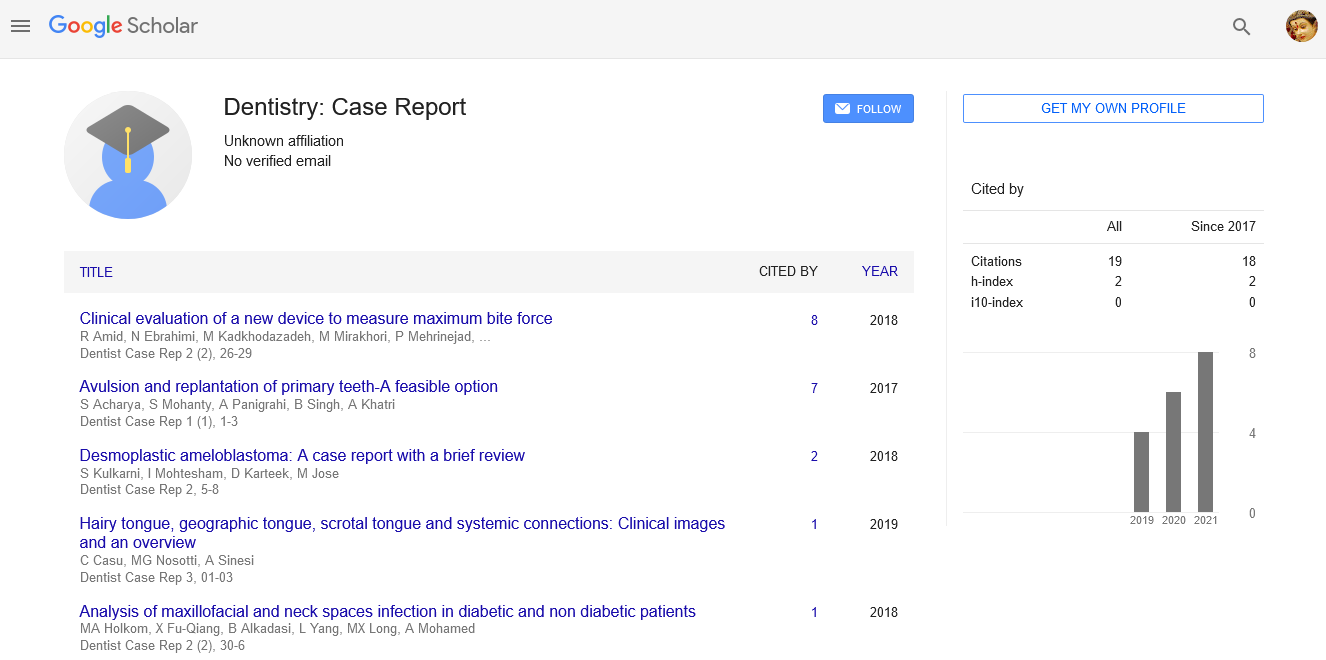New technologies of dentistry
Received: 07-Jan-2022, Manuscript No. puldcr-22-4657; Editor assigned: 10-Jan-2022, Pre QC No. puldcr-22-4657; Accepted Date: Jan 27, 2022; Reviewed: 20-Jan-2022 QC No. puldcr-22-4657; Revised: 25-Jan-2022, Manuscript No. puldcr-22-4657; Published: 27-Jan-2022, DOI: 10.37532. puldcr.22.6.1.1
This open-access article is distributed under the terms of the Creative Commons Attribution Non-Commercial License (CC BY-NC) (http://creativecommons.org/licenses/by-nc/4.0/), which permits reuse, distribution and reproduction of the article, provided that the original work is properly cited and the reuse is restricted to noncommercial purposes. For commercial reuse, contact reprints@pulsus.com
Introduction
The Dentistry is always developing and improving to better meet the requirements of patients can provide you with modern answers to traditional dental problems. These technologies primarily aid in the improvement of dental treatments that are more efficient, effective, and comfortable. Consider how far dental technology has progressed in recent decades: laser dentistry, digital X-ray machines, new gum procedures, improved veneers, no-needle anesthesia, and so on.
Any dental work that improves the appearance of teeth, gums, and/ or bite is referred to as cosmetic dentistry. It generally focuses on improving the colour, position, shape, size, alignment, and overall appearance of the teeth. Regardless of their exact school, specialty, training, or experience in this sector, many dentists refer to themselves as “cosmetic dentists”.
The application of dental expertise to criminal and civil laws enforced by police agencies in a criminal justice system is known as forensic dentistry or forensic odontology. The correct handling, examination, and evaluation of dental evidence, which will eventually be presented in the interest of justice, is referred to as forensic dentistry. Dental data, including radiographs, ante-mortem (before to death) and post-mortem (after death) pictures, and DNA are used to accomplish this.
Geriatric dentistry is the practice of providing dental care to senior citizens that includes the diagnosis, prevention, management, and treatment of age-related illnesses. The world's population is ageing, with an increase in the number and proportion of senior individuals. Between 2000 and 2005, the life expectancy at birth increased from 67.2 to 70.8 years. It is expected to continue to rise to 77 years by 2045-2050. The advancements in contemporary medicine and medical technology are largely responsible for this increase in longevity. Holistic dentistry, commonly referred to as biological dentistry, considers a person's full physical and mental well-being. Natural therapies (sometimes in combination with conventional ones) are used by holistic dentists to prevent, diagnose, and treat illnesses of the oral cavity. Holistic dentistry is an alternative approach to dentistry that stresses the unrecognized influence of dental toxins and infections on a person's general health and emphasizes the use of non-toxic restorative materials for dental work.
Traditional dentistry solely looks at the areas above the neck, whereas holistic dentistry considers the patient as a whole system and how the mouth interacts with the rest of the body.
Pediatric dentists specialize in the oral health of children from birth to adolescence. They have the training and knowledge to look after a child's teeth, gums, and mouth at all stages of development. During the first six months of life, children begin to develop their baby teeth. They begin to lose their initial set of teeth at the age of 6 or 7, which are eventually replaced by secondary, permanent teeth.
The process of caring for your teeth in order to keep them healthy is known as preventive dentistry. Cavities, gum disease, enamel wear, and other issues can all be avoided by doing so. Preventive dentistry includes things like daily brushing and teeth cleanings. The American Dental Association (ADA) suggests seeing the dentist at regular intervals established by a dentist to maintain maximum oral health. These procedures are intended to keep teeth clean, strong, and white. At a young age, children should be taught appropriate mouth hygiene.
Advanced Dental Research (ADR) is described as the study, identification, prevention, and treatment of surgical and nonsurgical diseases, ailments, and disorders of the oral cavity and maxillofacial region. Advanced Dental Technology offers a higher degree of dental technology education as well as dental science research. Advanced dental ceramics, implantology, and CAD/CAM technology are some of the most recent innovations. It aids in comprehending the connections between research and clinical application, as well as the limitations that arise.
Restorative Dentistry is the term dental professionals use to explain how they replace missing or damaged teeth. Fillings, crowns (“caps”), bridges and implants are common restorative options. The goal is to bring back your natural smile and prevent future oral health issues. The most common way to treat a cavity is for your dentist to remove the decay and fill the tooth with one of several different materials. These filling materials include gold, porcelain, silver amalgam (which consists of mercury mixed with silver, tin, zinc and copper), tooth-colored plastic or composite resin.
Dental Injuries are the most common type of Orofacial injury sustained during participation in sports. It mainly includes the prevention and management of athletics-related orofacial injuries and associated oral disease.
A dental Implant is a titanium post (like a tooth root) that is surgically positioned into the jawbone beneath the gum line that allows your dentist to mount replacement teeth or a bridge into that area. An implant doesn't come loose like a denture can. Dental implants also benefit general oral health because they do not have to be anchored to other teeth, like bridges.





